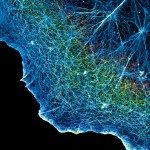Link to Pubmed [PMID] – 18199661
Biophys. J. 2008 Apr;94(8):3323-39
How site-specific transcription factors scan the genome to locate their target sites is a fundamental question in gene regulation. The in vivo binding interactions of several different transcription factors with chromatin have been investigated recently using quantitative fluorescence recovery after photobleaching (FRAP). These analyses have yielded significantly different estimates of both the binding rates and the number of predicted binding states of the respective transcription factors. We show here that these discrepancies are not due to fundamental differences among the site-specific transcription factors, but rather arise from errors in FRAP modeling. The two principal errors are a neglect of diffusion’s role and an oversimplified approximation of the photobleach profile. Accounting for these errors by developing a revised FRAP protocol eliminates most of the previous discrepancies in the binding estimates for the three different transcription factors analyzed here. The new estimates predict that for each of the three transcription factors, approximately 75% of the molecules are freely diffusing within the nucleus, whereas the remainder is bound with an average residence time of approximately 2.5 s to a single type of chromatin binding site. Such consistent predictions for three different molecules suggest that many site-specific transcription factors may exhibit similar in vivo interactions with native chromatin.


